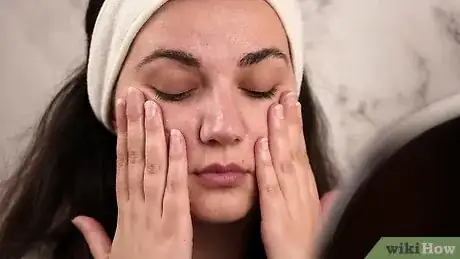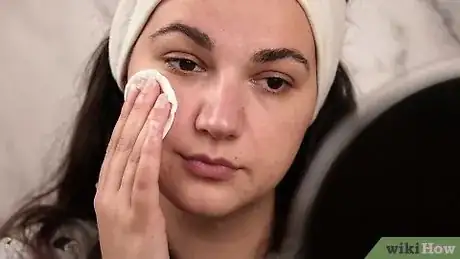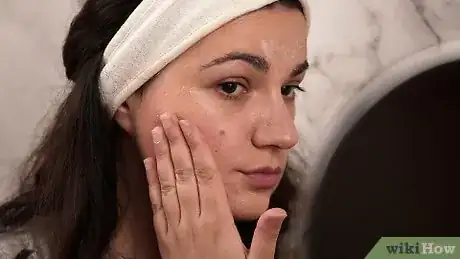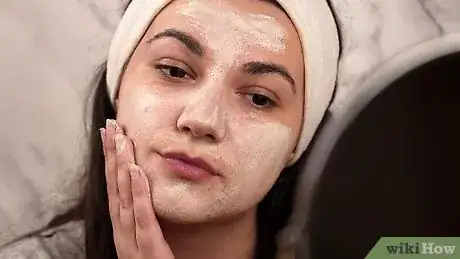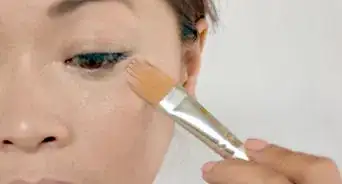This article was co-authored by Devorah Kuperland. Devorah Kuperland is a Makeup Artist and the Founder of Glam By Dev, a New York City-based business specializing in bridal, special events, and editorial campaigns. Devorah has over five years of professional makeup consulting experience and her work has been featured in New York's Bridal Fashion Week.
There are 16 references cited in this article, which can be found at the bottom of the page.
wikiHow marks an article as reader-approved once it receives enough positive feedback. In this case, 100% of readers who voted found the article helpful, earning it our reader-approved status.
This article has been viewed 575,489 times.
For those prone to oily skin, the makeup application process revolves around combating excess oil. During the actual application, this battle is fought with oil-free, mattifying moisturizers, foundations, and finishing powders. Throughout the day, you must fend off unwanted shine with blotting paper and pressed powder.
Steps
Preparing Your Skin
-
1Pre-cleanse and cleanse your face. When you apply makeup, it is best to begin the application on a clean, well-hydrated canvas. Prior to cleansing your face, you should pre-cleanse your skin. Rinse your face with warm water to remove dirt and oils from the surface of your skin. Apply a gentle cleanser to your clean, damp face. Rinse away the product and pat your face dry with a clean towel.[1]
- Resist the urge to wash your oily skin multiple times a day. This will strip your face of its natural moisture and send your oil production into hyperdrive. Instead, wash your face once in the morning and once in the evening before bed.
-
2Apply toner. Toners are formulated to remove excess dirt, makeup, and oils from your skin. Saturate a cotton ball with your oil free toner. Wipe the cotton ball across your face—avoid your eyes. Allow the product to air dry.
- To avoid dehydrating your skin, use an alcohol-free toner once per day.
- Rosewater and witch hazel are excellent natural toners.[2]
Advertisement -
3Moisturize your skin. Your pores are over producing oil to compensate for dehydrated skin. Although it seems counterintuitive, oily skin needs additional moisture. It does not, however, need any additional oil. When you select a moisturizer, look for a lightweight product that is oil-free, mattifying, and shine-reducing. Apply a thin layer of light moisturizer to your face.[3]
- Mattifying moisturizers actually help to absorb excess oil from your skin.[4]
- Select a SPF moisturizer for extra protection.[5]
- Even if you have oily skin, you likely need to moisturize, and avoid using products with drying ingredients like alcohol. Often, oiliness on your skin is actually caused because your skin isn't hydrated enough, so it overproduces oil. Instead, try to find a good balance of moisture for your skin that will help you combat oil.[6]
-
4Exfoliate your skin 3 to 4 times per week. Oily skin causes your skin to overproduce oil and skin cells, which build up and clog your pores. To prevent this, exfoliate your skin 3 to 4 times per week with an exfoliating wash. Apply the exfoliant to wet skin and then massage it into your skin using a circular motion. Rinse your face thoroughly and pat your skin dry.
- Choose a chemical exfoliant, such as one that contains beta-hydroxy acid.
- Look for a sugar scrub for a gentle way to exfoliate your skin.[7]
Applying Makeup
-
1Apply a matte primer to your face and eyelids. Primer provides a smooth, shine free base for your makeup. These products prevent your makeup from “melting” off your face. When selecting a primer, opt for a mattifying, oil free product in a powder or liquid-to-powder form. Apply a thin, even layer of primer to your face—don’t forget your eyelids.
- You can purchase and apply a separate primer for your eyelids.[8]
-
2Conceal your blemishes. Oily skin is prone to breakouts and blemishes. Applying light layers of liquid matte concealer will help to minimize these imperfections without causing new breakouts. Use the wand or a concealer brush to cover your dark circles, red marks, and imperfections.
- For additional coverage, apply a layer of liquid concealer, followed by a layer of powder foundation and another layer of liquid concealer. Seal in the makeup with a final coat of powder foundation. The more layers you apply, the less likely you are to see shiny spots throughout the day. This application method may require several touch ups.
- Avoid cream concealers—they will clog your pores.[9]
-
3Use a foundation formulated for oily skin. Long-lasting powder foundations create an even complexion while combating excess oil. Before you purchase foundation, read the label carefully—make sure the product is oil-free, mattifying, and noncomedogenic (will not clog your pores). Apply a thin, even layer of powder with a large powder brush. Move the brush in a circular and dabbing motion.
-
4Apply a loose finishing powder. Translucent matte powder provides another barrier against oily skin. Pour a small amount of powder into the makeup container’s lid. Swirl a kabuki brush or a powder brush inside the lid until all the powder disappears. To apply a thin coat of matte finishing powder over your foundation, move the brush in big circles from the inside of your face to the outside of your face.
- You can apply the powder to your eyelids too.[12]
-
5Add a flush to your cheeks. Mattifying blush will produce a radiant glow while fighting off excess oil. You may apply the powder matte blush with a traditional blush brush or a powder blush. Circle the brush from the apples of your cheeks to your upper ear.[13]
- Avoid shimmery blushes because they will make you look shiny.
- Powder matte blush will stay on your cheeks longer than a cream matte blush.[14]
Combating Oily Skin Throughout the Day and Week
-
1Blot away oil. At some point in the day, your natural oils will inevitably seep through your matte makeup. Blotting paper will remove the spots of oil from your face without wiping away your makeup. Gently press a sheet of blotting paper onto the oily spot—do not rub it across your entire face. Once the oil is absorbed, carefully peel the paper off of your skin.
- You can purchase blotting paper that will absorb oil AND leave powder on the oily spot.[15]
-
2Mask the oily spot with powder. After you have removed the oil, cover the area with powder. The powder will help to absorb any remaining oil and help you maintain an even complexion. Use a puff, sponge, or beauty blender to press the powder into the oily spot.
- Always carry powder with you.[16]
-
3Apply an oil-fighting face mask. Once or twice a week, consider treating yourself to an oil-absorbing face mask. Find a mask that contains kaolin or bentonite clay. Apply a thin layer of the mask to your face. Allow it to harden for 10 to 15 minutes. Rinse off the mask with warm water.
- Kaolin or bentonite clays absorb oil while soothing irritations.[17]
Expert Q&A
Did you know you can get expert answers for this article?
Unlock expert answers by supporting wikiHow
-
QuestionWhat makeup should I use for oily skin?
 Laura MartinLaura Martin is a Licensed Cosmetologist in Georgia. She has been a hair stylist since 2007 and a cosmetology teacher since 2013.
Laura MartinLaura Martin is a Licensed Cosmetologist in Georgia. She has been a hair stylist since 2007 and a cosmetology teacher since 2013.
Licensed Cosmetologist
-
QuestionWhich face powder is best for oily skin?
 Laura MartinLaura Martin is a Licensed Cosmetologist in Georgia. She has been a hair stylist since 2007 and a cosmetology teacher since 2013.
Laura MartinLaura Martin is a Licensed Cosmetologist in Georgia. She has been a hair stylist since 2007 and a cosmetology teacher since 2013.
Licensed Cosmetologist
-
QuestionWhich foundation is best for oily skin?
 Laura MartinLaura Martin is a Licensed Cosmetologist in Georgia. She has been a hair stylist since 2007 and a cosmetology teacher since 2013.
Laura MartinLaura Martin is a Licensed Cosmetologist in Georgia. She has been a hair stylist since 2007 and a cosmetology teacher since 2013.
Licensed Cosmetologist
Warnings
- If using a primer, make sure it is oil free.⧼thumbs_response⧽
References
- ↑ http://stylecaster.com/beauty/how-to-take-off-your-makeup/
- ↑ http://makeupandbeauty.com/tips-toning-moisturizing/
- ↑ http://www.marieclaire.co.uk/beauty/best/13989/moisturiser-for-oily-skin.html
- ↑ http://www.makeup.com/oily-skin-makeup-tips
- ↑ http://stylecaster.com/beauty/oily-skin-tips/
- ↑ Devorah Kuperland. Makeup Artist. Expert Interview. 7 April 2020.
- ↑ https://www.allure.com/story/how-often-should-you-exfoliate
- ↑ http://www.webmd.com/beauty/makeup/oily-skin-how-to-make-makeup-last, http://stylecaster.com/beauty/oily-skin-tips/, http://youqueen.com/beauty/makeup/makeup-tips-for-oily-skin/, http://stylecaster.com/beauty/primers-for-oily-skin/, http://www.huffingtonpost.com/2015/01/16/what-is-makeup-primer_n_6463190.html
- ↑ http://www.paulaschoice.com/expert-advice/eyes/_/how-to-choose-and-use-concealer, https://www.youtube.com/watch?v=VG55TNfqY7k
- ↑ http://www.webmd.com/beauty/makeup/oily-skin-how-to-make-makeup-last, https://www.youtube.com/watch?v=bA5ggYAIeC8
- ↑ http://naturalbeautytips.co/makeup-tips-for-oily-skin/
- ↑ http://www.divinecaroline.com/beauty/makeup/makeup-tips/makeup-artists-secret-weapon-powder
- ↑ http://www.realsimple.com/beauty-fashion/makeup/makeup-face/how-to-apply-blush/faq-blush, http://stylecaster.com/beauty/oily-skin-tips/
- ↑ http://naturalbeautytips.co/makeup-tips-for-oily-skin/
- ↑ http://www.webmd.com/beauty/makeup/oily-skin-how-to-make-makeup-last
- ↑ http://www.makeup.com/oily-skin-makeup-tips
- ↑ http://www.webmd.com/beauty/makeup/oily-skin-how-to-make-makeup-last, http://stylecaster.com/beauty/how-different-types-of-clay-benefit-your-skin/
- Videos provided by Michelle Dy
About This Article
One way to apply makeup on oily skin is by using makeup that is formulated for oily skin. Start by applying a mattifying primer all over the face, and use concealer to cover any blemishes. Then, apply an oil-free, mattifying foundation for oily skin all over your face, and set the foundation by applying an even layer of loose finishing powder over your skin with a brush. Pick a mattifying blush to bring color to your cheeks without adding shine to your skin. For more information, including how to manage oily skin throughout the day, keep reading!
